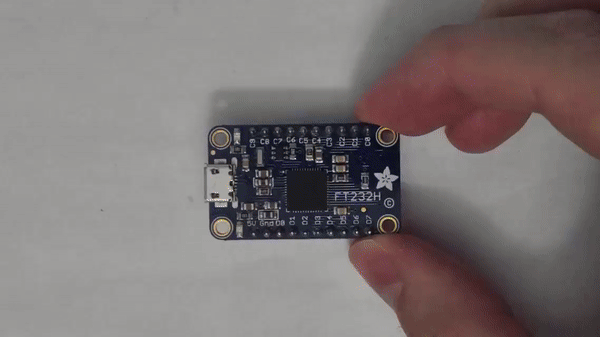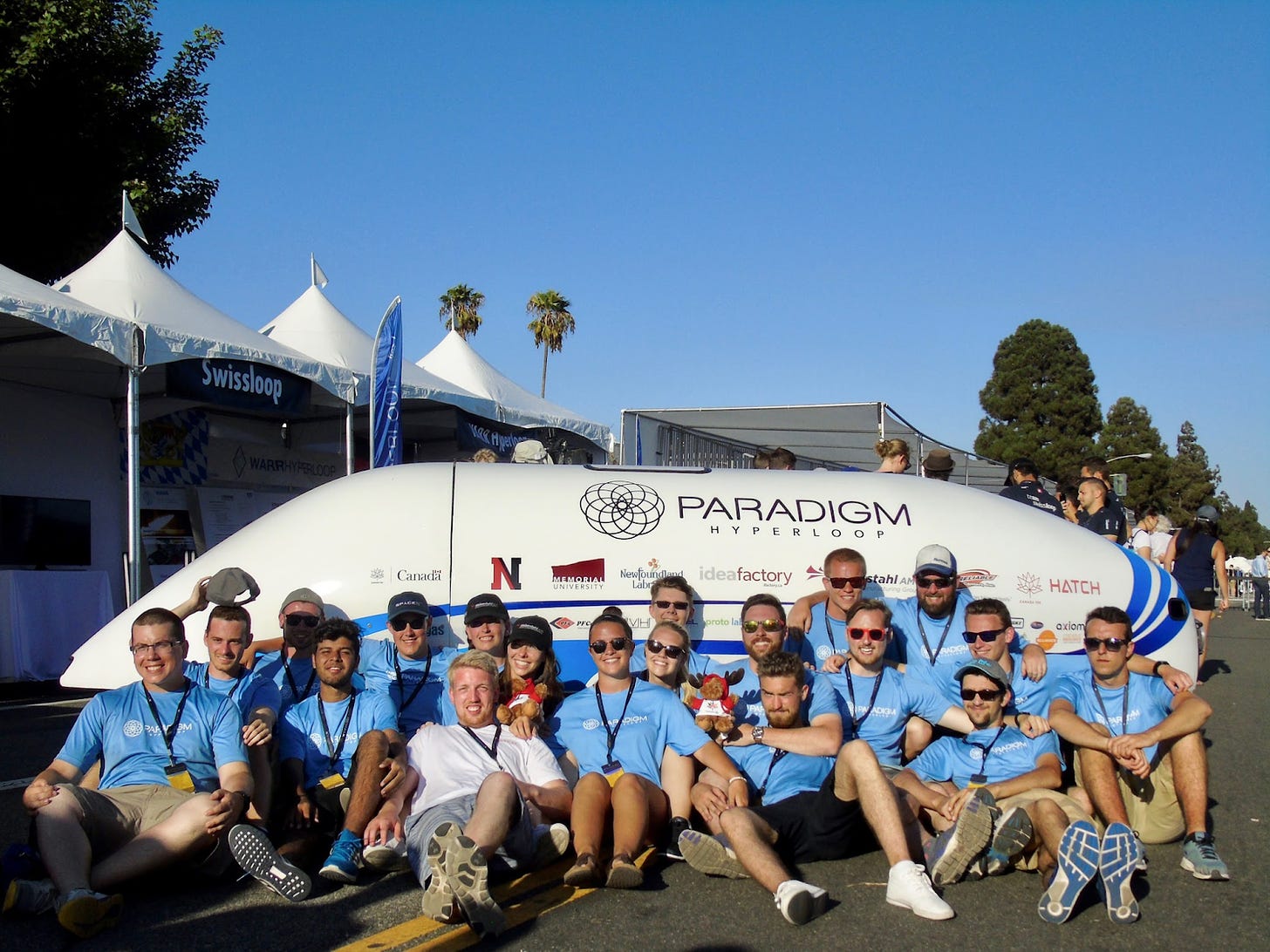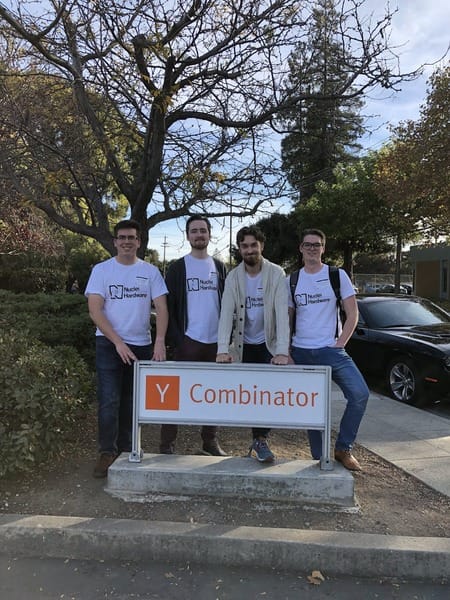I co-founded a CAD company called inspectAR with a few undergrads from Memorial University of Newfoundland (MUN). The goal was to bring PCB manufacturing data to life in augmented reality, making it accessible on any platform—Windows, MacOS, Android, iOS, you name it.
In the end, Cadence Design Systems acquired us and we continued developing our tech there. We learned a lot in those 20 months: about the CAD market, what it takes to sell to engineers, and how to build something that attracts an acquirer without needing massive investment. Hopefully, sharing this journey helps others navigate the leap from idea to commercial success.

Background
Meeting my Co-Founders
During my time on campus, I made close friendships with other engineering students, especially through extracurricular teams. My school had a highly competitive Hyperloop team, and in 2017 MUN won 2nd place overall at the annual Hyperloop Pod Competition.
This opened the door to some incredible opportunities. A future co-founder and I were interviewed and brought on as interns at Neuralink, back when the company had fewer than 50 employees.

Late Evenings and Weekend Development
At Neuralink, Darryl and I found ourselves doing the same tedious task over and over: inspecting wire bonds from ASICs on a custom PCB and tracking results in a spreadsheet. The board had four identical ASICs, but each one was rotated differently. As we moved down the array, we would have to “re-map” what each pin did as we looked under magnification.
After the internship, we headed back to school for our senior year, where we were required to complete a capstone project. The work at Neuralink sparked an idea:
What if we could automate the tedious process of inspecting and mapping these wire bonds?
We originally thought a microscope with an augmented reality interface might boost productivity—or, at the very least, make for a unique project.
Between classes and late nights, we lined up over 50 customer discovery calls with senior engineers to validate our idea. Most agreed: if we could make this “magic microscope,” they’d use it in their labs! With a bit more prodding, they also expressed that they felt a smartphone, laptop + webcam, or even some AR glasses could also work. With a C$500 capstone budget and the need for a prototype, we pivoted from the microscope and into a solution using off-the-shelf (OTS) hardware and software to display CAD data in AR.
By November, we had secured an interview for YC’s W19 batch. This meant round-trip flights for all four of us—over a 10 minute interview!
We booked the flights a week early to make the most of it, and conduct more in-person customer interviews and pitch the idea to other investors in the Bay Area. We didn’t make it into the W19 batch, but one connection from that trip turned out to be pivotal: it led us to our final co-founder and future CEO.

Technical Discussion on Augmented Reality in PCB CAD
There were major components to our solution which would have to be built out in order for this to work, with problems arising with each:
- Problem: File Input.
- We had to intelligently interpret a PCB design to display in AR. Gerbers (layer-by-layer image data) were a basic start, though there was much more metadata that we wanted to display.
- Solution: We found a common manufacturing file input which used an openly available standard and could be exported by all major PCB design tools, IPC2581B.
- Problem: Application clients & augmented reality stack.
- We needed a client application to execute the computer vision algorithms that displayed information in AR.
- Solution: We found that we could support most platforms with the Unity game engine, which was becoming an industry standard in augmented reality applications.
- Problem: Backend service to share and distribute information between clients.
- Solution: There are no mobile PCB design software solutions, however augmented reality software is predominantly run on mobile or glasses based hardware. We built a backend that transmitted design and derivative information between the clients.
- Problem: Frontend service
- Given the difference in platform technologies between PCB design software and AR software, we also needed a frontend for our backend services to link the two technology stacks together.
- Solution: Most PCB design software was built for desktop OS, while our target users were on mobile or glasses-based OS, making a web application the natural choice. This platform eventually evolved into an enterprise portal where teams could be managed for a company’s SaaS plan.
After building our first revision of the software platform, we set out to raise capital to further develop the product and expand our sales efforts.

Investment and Product Market Fit
We met Mihir through a mutual connection—he became our final cofounder and CEO. After a few meetings, our talks had advanced to the point where we knew what we wanted to scale this as a full-time venture.
He saw the vision, knew the customers, and wanted to make a strategic, hands-on investment. It was smart capital. With his background as an EE and experience in his family’s PCB manufacturing business, we decided he would be our best option for the first round. There was a high probability that we would have to pivot our technology towards a manufacturing vertical, away from the engineer who designs the circuit board and more towards the factories that have to build them. Partnering with someone embedded in PCB manufacturing from the start was a big advantage.
Early Hiring and Enterprise Customers
Some of our early issues in sales, product, and eventual solutions can be boiled down as follows:
- Product too early: We kept up with customer relationships and organized pilot projects for the future, once we had the necessary functionality. When needed, we raised additional capital to build out those critical features.
- Limited Capacity for Diligence: We raised capital to make hires dedicated to handling company diligence, including technical hires to develop the product with compliance requirements in mind (SOC2, etc.).
- It’s best to hold off doing this until you’ve generated enough sales or strong interest to qualify that there exists an addressable market.
- Customer Resistance to Cloud: For clients hesitant to use cloud-based solutions, we developed a self-hosted instance, which also required additional headcount for implementation.
A big turning point for product adoption was at a major user conference for Altium Designer, the leading PCB design software package in our industry. Normally these booths cost quite a bit of money, but we managed to secure a free spot. Our goal for the weekend was to try and have hundreds of interactions with users and get a broad base of feedback for our product.
Talking to our core audience made a big difference: they immediately understood the product's value. Our tool let people working on unfamiliar PCBs save time by reducing context switching between their screen and the device they were testing.

During the conference, we secured numerous highly qualified leads and hundreds more that we were able to reach out to later. Over the next few months, these leads turned into about a dozen trials and a handful of enterprise deals.
This included landing our first enterprise deal with the Philips Sonicare toothbrush team! At first, it seemed a bit surprising to us, but the Philips team turned out to be a great fit for our product. Their smart, IoT toothbrushes and other dental products aligned well with our tool. It was invaluable experience to start navigating sales with large enterprises.
Through this, we also gained hands-on experience working with strict regulations like ITAR and EEA. Handling data subject to these regulations required us to ensure compliance with national security protocols. It was a deep dive into understanding and managing the complexities of regulated environments, that opened up our reach to bigger players in the industry.

We applied a similar playbook to other prospects in our pipeline, and eventually landed more enterprise deals with teams at Google, Fitbit, and Quantel Laser.
COVID-19 and Start of Acquisition Negotiations
In May 2020, we were contacted by the corporate development team of Cadence Design Systems, the largest player in our space. Acquisition had always been the long term strategy of our business and in light of the pandemic, Cadence presented an interesting opportunity to get inspectAR into their customers’ hands while the market was adapting.
We closed the acquisition in August of 2020 and never looked back! Some key lessons that seem prescient now in hindsight are:
- Leverage co-founders: a productive founding team will be a force multiplier and is exactly what acquirers want from a small strategic acquisition.
- Focus on becoming a vertical integrator of technologies which are already well established, so you can build a functional product without significant R&D.
- Connect with potential acquirers to build relationships with their customers—or even those of a competitor! We primarily served Altium users at the time of acquisition, which added a strategic advantage.



